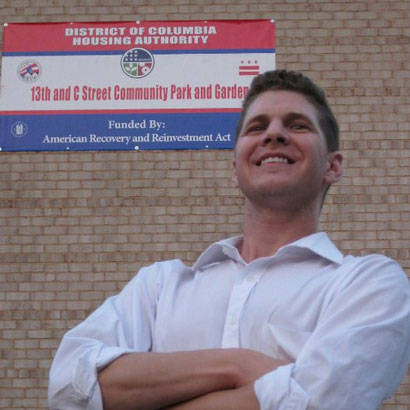
Having studied history and political science at Gettysburg College, when I arrived in Washington, D.C., in 2000, the city’s extensive Civil War legacy — emblazoned in bronze and stone — was not lost on me. I enjoyed walking the historic streets of Capitol Hill, which Abraham Lincoln and Frederick Douglass had traversed well over a century before. And, I wondered if any park benches or shade trees had similarly provided them with a moment’s respite from the raging war that divided the nation.
Thanks to its late 18th-century designer, Pierre L’Enfant, Washington does not lack for green spaces. The city comes in fourth for its park system on The Trust for Public Land’s ParkScore index, which ranks the 100 most populous U.S. cities based on park access, acreage and funding.
However, when I moved to southeast Capitol Hill in my mid-20s, I seemed to have found one of the city’s few patches of undesired concrete lots: a vestige of the car-centric and failed urban renewal program that scars many cities to this day. This abandoned, fenced-off parking lot, adjoining a public housing complex, was not only an eyesore, but also a public health and safety hazard that attracted hordes of mosquitoes after summer rains and frequent ne’er-do-wells trafficking in illegal behavior when the sun set.
Plant the Right Seeds
At the urging of my neighbor, a small group of 20- and 30-year-olds gathered one evening in his parlor to consider how that lot could better serve the community. Why not a park, we wondered, inspired by images of picnic tables, playsets and a verdant lawn, all replacing the existing black top? But, how could this idea become a reality? None of us knew anything about creating a park: Who owned the land? How much would it cost to build? Where would the funding come from? What did the community really want?
Find Your Champions
As fate would have it, weeks later, during a neighborhood safety walk with the DC Housing Authority executive director and a local councilmember, I approached the officials and shared our group’s idea for a park. Both men embraced the concept and committed to transforming the space, but only if our small group agreed to spearhead the community engagement.
We quickly incorporated our ad hoc citizen assembly into an official nonprofit “friends of group,” the 13th Street Community Park and Garden. Because I was an urban planning professional, albeit a very green one with no experience tackling such a project, I was pressed into service as the organization’s president. Working in partnership with the housing agency, we held outreach meetings and a community charrette with the public-housing residents and the larger neighborhood. Luckily, we had the pro-bono talents of an architectural designer and a landscape architect to guide us through park options.
From the community, we quickly learned that the senior citizens, who comprised the largest demographic of the neighboring housing complex, had no interest in playsets or active recreation areas for the site. Instead, they wished for a more peaceful place to relax and reflect. And, interestingly, many of the older residents, some who grew up with agricultural backgrounds, called for a community gardening space.
After several months, with an agreed-upon conceptual design, we testified before the housing board, and the project was allocated $250,000. Ground was ceremoniously broken and all seemed right with the world. Except, as many of us learned, very few construction projects ever go as planned. Design challenges and their costs quickly outpaced our budget, and work on the park stalled. The housing residents and neighbors grew restless.
Keep the Long View
For more than two years, each time I stepped out my front door I had to dodge complaints about the project and what, to many, was beginning to look like false promises. Behind the scenes, however, our nonprofit was walking a delicate tightrope of politicking and advocacy. The housing director and councilmember remained our champions throughout, but bureaucracy and financial realities cast a pall on what should have been a feel-good task. Eventually, the housing agency, with the help of the board, successfully applied for and was awarded a federal grant to complete the park, securing more than $650,000. After four years of dedication by dozens of community members, the 13th and C Street Community Park and Garden finally became a reality and, to this day, remains a beloved gem of the community.
Be a Gracious Agitator
Two miles due south of our new park is the Frederick Douglass Cedar Hill house and historic site. It was here that the abolitionist, civil rights advocate and statesman lived from 1877 until his death in 1895. A year before his passing, a young man approached Douglass at his home and asked how he could make a difference in this world. “Agitate,” Douglass replied. “Agitate, agitate.” I can offer no better advice to those hoping to create their own parks and protect natural spaces for future generations — except perhaps to do so with a smile and a sense of humor!
Richard Lukas is Director of Federal Grants and Program Development at The Trust for Public Land and President of the 13th Street Community Park & Garden in Capitol Hill, D.C.

